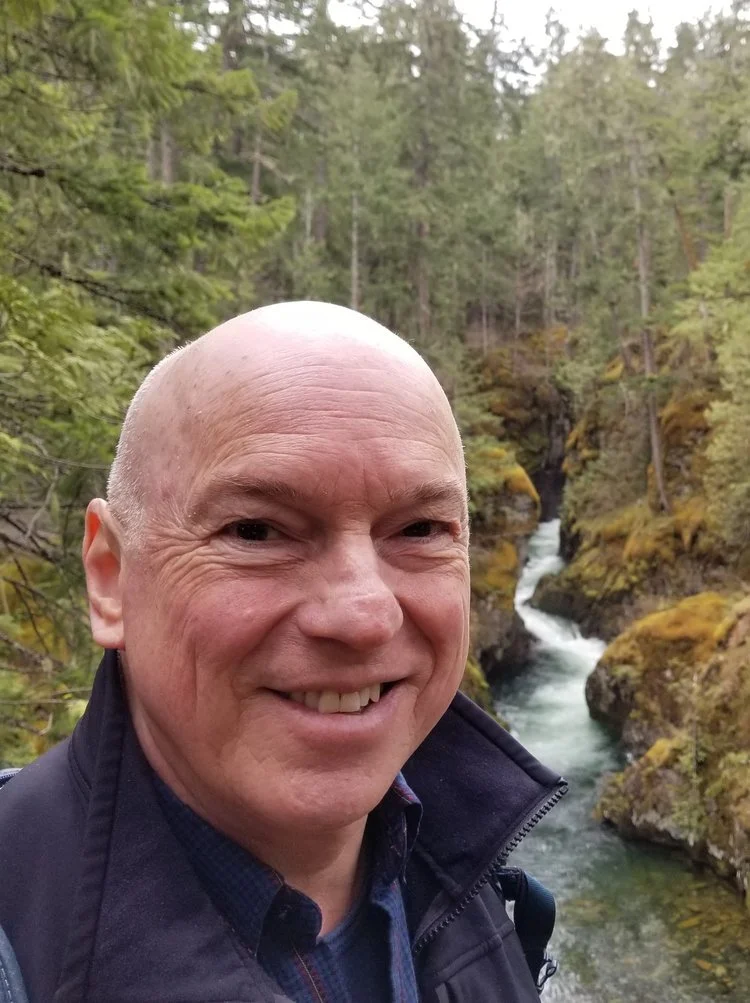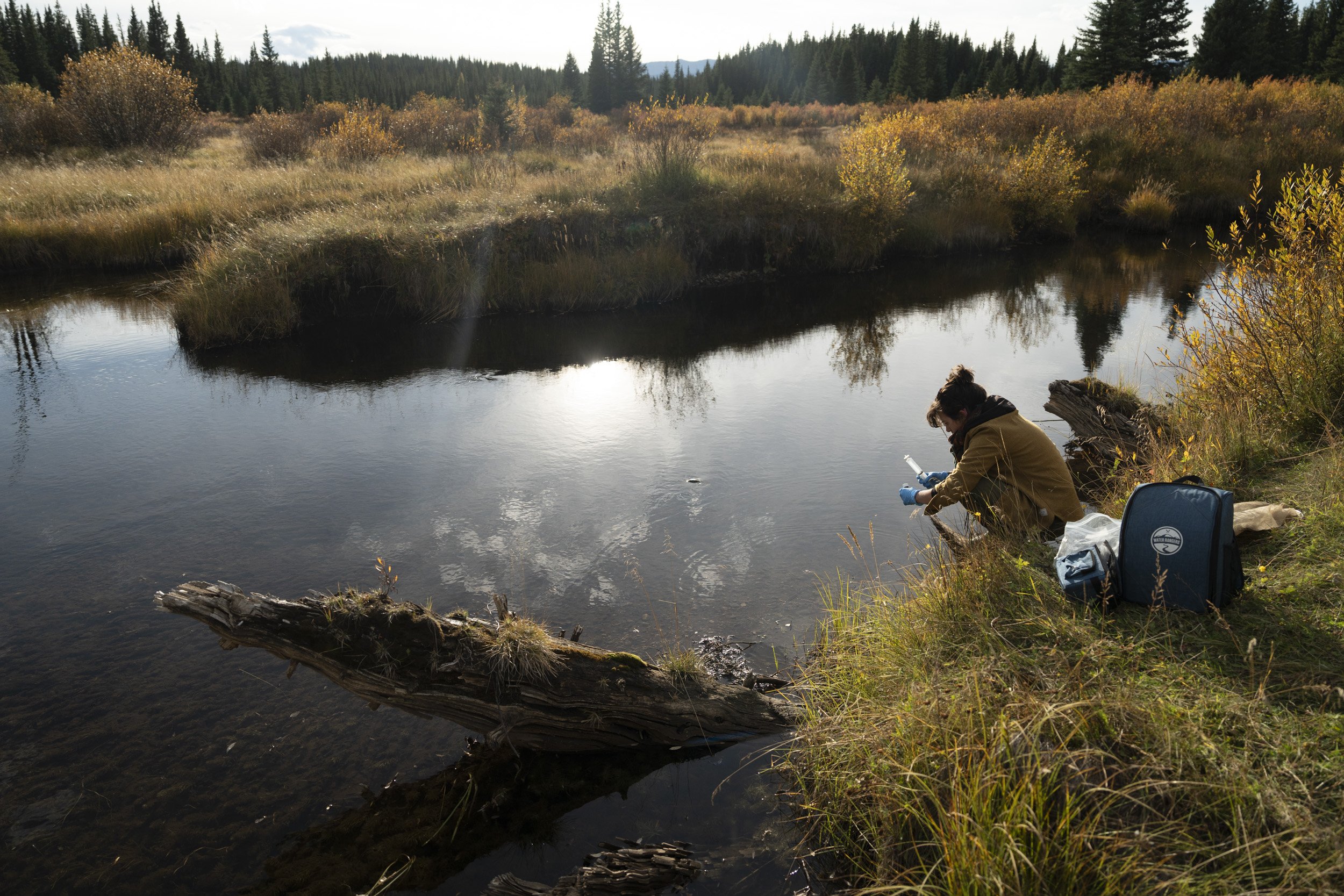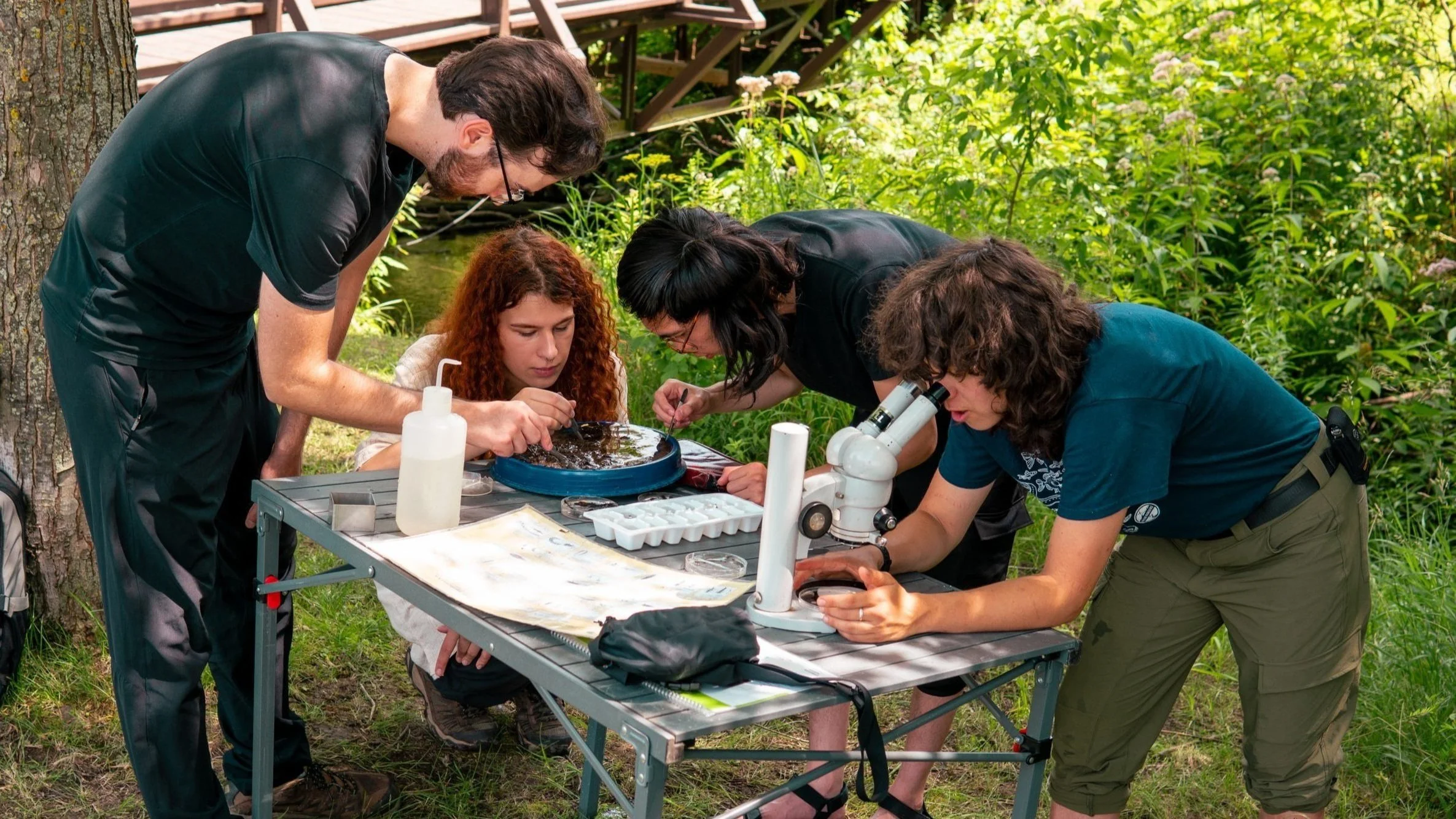
The Legacy of Forestry on Freshwaters:
Revealing Resilience in Canada’s Streams
2024 Trebek Grantee
Dalal Hanna
When Forests Fall, Rivers Change
Forests Shape Waterways
Forests shape the rivers that run through them.
Their roots hold soil in place, shade the water, and help maintain the cold, clear conditions that many species rely on.
When those trees are removed, rivers begin to change.
Sometimes the shift is immediate. Sometimes it takes decades. Over time, these impacts become evident in rising temperatures, shifting sediments, and declining biodiversity.
Uncovering the Long-Term Effects of Logging on Canada’s Rivers
To understand what forests leave behind, you have to sample the water. Dr. Dalal Hanna, a 2024 Trebek Grantee and National Geographic Explorer, is leading Canada’s first cross-country field study on how forestry affects freshwater ecosystems.
Her research uses eDNA sequencing, historical land-use mapping, and water sampling to track how freshwater species respond in the decades after logging, identifying where recovery occurs and where it does not.
This work goes beyond identifying the problem. By involving students and communities across the country, the project is building the most detailed picture yet of how forests and rivers are connected.
The findings will inform stronger approaches to freshwater protection and forest management.

Revealing Hidden Life:
Using eDNA to Discover Water’s History
Freshwater ecosystems teem with life, even when it’s not visible.
Each fish, amphibian, and insect leaves behind genetic traces in the water, forming a molecular record of biodiversity.
Through environmental DNA (eDNA) analysis, Dalal’s team can:
Detect species too small or elusive to be identified through traditional methods.
Track species returning after logging and those that have vanished.
Use a non-invasive, high-precision approach to monitor ecosystem health across hundreds of water samples from streams.
eDNA is a powerful tool that provides an unprecedented view into biodiversity trends, helping to track recovery and pinpoint the species most affected by logging.
This method enables researchers to collect large-scale data that can inform national-level conservation efforts.
Find out how Stream Blitz is engaging students across Canada
EXPLORE THIS PROJECT
FORESTRY & FRESHWATER
What does sustainable forestry really look like?
This video explores how practices like buffer zones and selective harvesting can reduce the impact of logging on rivers and lakes, and highlights how Dalal Hanna’s research team at Carleton University is guiding smarter environmental decisions for Canada’s forests and freshwater.
HIDDEN BIODIVERSITY
What Rivers Can Tell Us Without Words
Much of what’s changing in rivers is invisible. Dalal’s team uses environmental DNA to detect aquatic species too small or too elusive for traditional methods.
These insights reveal where biodiversity rebounds and where it still struggles to return.
COMMUNITY ENGAGEMENT
A National Effort to Monitor River Health
Through the StreamBlitz program, over 300 students, teachers, and volunteers are building Canada’s most detailed map of stream health.
Together, they’re tracking biodiversity and creating useful data to support conservation.
GET INVOLVED
Help Track Canada’s Rivers and Streams
You don’t need to be a scientist to make a difference. With a MacroBlitz or Water Rangers kit, anyone can monitor rivers, track aquatic life, and contribute to real research.
StreamBlitz began in classrooms. Now it’s a national initiative open to families, students, and local groups who want to help protect Canada’s freshwater.

Monitoring Recovery Across Canada’s Logged Watersheds
Where freshwater recovers and where it does not
Dalal Hanna’s research spans 100 streams across five provinces, assessing how freshwater ecosystems recover following logging and identifying regions where recovery has not occurred.
Using environmental DNA, historical land-use mapping, and water sampling, her team is generating insights on:
Which species rebound, and which never return
How sediment buildup and warming waters disrupt ecosystems
Science-backed solutions to protect freshwater habitats
By filling key data gaps, this research will help inform the development of forestry policies that strike a balance between conservation and sustainable land management.
Fieldwork on the Forest’s Edge
These images show the research in action. Dalal and her team are studying how logging affects water flow, stream structure, and aquatic life where the forest meets the river. 🔽 Follow the team into the forest and along the streambanks.

What Rivers Remember
Tracking Logging’s Lasting Impact
Canada’s rivers carry the imprint of the forests that once stood beside them.
Dalal’s team is studying Canada’s freshwater, from British Columbia’s salmon-bearing rivers to the boreal waters of Quebec. Each recovery story is unique.
Some sites were recently logged and are still adjusting to the changes in the surrounding landscape. Others were logged decades ago, yet their waters still reflect the impact. These rivers serve as living laboratories, offering a rare opportunity to study the long-term effects of logging on freshwater ecosystems.
The research reveals how biodiversity shifts over time and how land-use decisions continue to shape these systems.
In the Field
Reaching these research sites takes time and grit. Dalal and her team hike through dense forest and over rugged terrain, carrying gear and gathering evidence from waters few people see. This is the heart of field science, where data begins and the story of recovery takes shape. 🔽 Walk with the team into landscapes shaped by disturbance.
Restoration Leads to Recovery
“Streams show remarkable resilience, with biodiversity and water quality often improving quickly after disturbances caused by logging in their surrounding areas. But without intentional planning, such as maintaining streamside vegetation or building proper stream crossings, recovery can stall and leave ecosystems vulnerable for decades.”
When Forests Fall, Rivers Respond
Long-term monitoring reveals how logging affects rivers and helps to inform sustainable forest and water management.
The Lasting Impact of Logging on Freshwater Ecosystems
Carleton University researchers are studying how forest loss affects freshwater ecosystems decades after timber harvest.
⬇️ See how this research is revealing the legacy of logging and helping to inform planning decisions
StreamBlitz Engages Students Across Canada
“This project pioneers the first cross-country, field-based assessment of stream water quality and biodiversity recovery 50 years after timber harvesting. By leveraging advanced eDNA metabarcoding techniques, we capture hidden biodiversity trends and inform sustainable forestry practices that balance ecological health with economic needs.
”
Join the Freshwater Monitoring Movement
Help Track Canada’s Rivers and Streams
StreamBlitz started in classrooms, where students used MacroBlitz and Water Rangers kits to explore their local waterways. Now, individuals and families can sign up to help monitor rivers and streams across Canada. Both kits are simple to use and include clear, step-by-step guides. No experience needed, just curiosity and a willingness to explore your local environment.
Use a MacroBlitz kit to discover aquatic macroinvertebrates like mayfly nymphs and caddisflies. These tiny creatures are indicators of stream health.
Photograph what you find and upload your observations to iNaturalist to support national biodiversity research.
Try a Water Rangers kit to test water temperature, clarity, conductivity, and more.
Your results are added to an open data platform used by scientists, communities, and policymakers to track changes over time.
Driving Sustainable Impact
Canada’s freshwater ecosystems face growing threats from logging, climate change, and habitat loss, but they are also sites of action. Scientists, Indigenous stewards, and community scientists are working together to track stream health, guide restoration, and ensure conservation is based on real data.
Through this project’s StreamBlitz, over 300 students, teachers, and volunteers are helping build Canada’s most detailed map of stream health. Their findings shape restoration projects, guide conservation planning, and inform forestry policies, ensuring resources are focused where they are needed most.
🔽 Explore how community-driven science is protecting Canada’s rivers.
Empowering Communities and Informing Policy
StreamBlitz: Engaging Citizen Scientists
-
Over 300 participants track biodiversity and stream health across Canada.
eDNA and water quality monitoring identify how quickly streams do, or don’t, recover following timber harvesting. .
Findings guide watershed protection efforts.
-
Data collected as part of this project’s StreamBlitz shapes forestry regulations and future watershed protection.
eDNA tracking reveals which logged watersheds are slowest to recover, directing better land-use planning.
Conservation groups use this data to advocate for stronger protections in high-risk areas.
-
Students across nine provinces contribute real-world data, connecting classroom science to conservation.
Participation strengthens environmental awareness and inspires the next generation of conservation leaders.
Data Driven Insights: That Drive Action
-
Dalal Hanna’s team maps biodiversity shifts across Canada.
Findings help prioritize watershed restoration and sustainable forestry policies.
-
Data supports policies that balance ecological health with economic needs.
-
GIS mapping identifies streams across all of Canada, capturing both pristine and heavily logged areas.
Site with varying histories of logging in their watersheds are selected.
Each site provides a timeline of recovery, offering insights into how ecosystems heal ,or struggle,over time.
This approach uncovers patterns and gaps in current land use planning, guiding more effective conservation strategies.
-
eDNA sampling captures genetic traces of aquatic life, including fish, amphibians, and insects, from a single water sample.
This technique tracks biodiversity shifts, identifying trends in community composition and how freshwater biodiversity is or isn’t able to recover following surrounding logging.
Unlike traditional netting or electrofishing, eDNA offers a non-invasive, high-precision tool for large-scale ecosystem monitoring.
-
StreamBlitz brings hands-on water sampling and biodiversity tracking to local communities.
Community scientists and students contribute real-time data, contributing to a national freshwater health assessment.
These events build awareness, knowledge, and a shared responsibility for protecting rivers and streams.
-
In the lab, metabarcoding sequences eDNA to map biodiversity shifts.
Analyzing these genetic patterns reveals how species respond to environmental stress, including the impacts of logging.
Findings uncover key factors that accelerate or slow recovery, shaping targeted conservation efforts.
How We Study Stream Recovery
What’s Next:
What’s Next: Expanding Impact & Shaping Policy
Dalal Hanna’s research is laying the foundation for long-term freshwater conservation, ensuring that forestry policies are based on scientific evidence and real-world data on ecosystem recovery.
-
Findings from over 100 streams will inform landscape-scale planningregulations, guiding how forestry practices can better protect watersheds.
eDNA biodiversity tracking will continue to highlight which rivers struggle to recover, helping policymakers prioritize conservation funding for high-risk areas.
Research will contribute to national and provincial sustainable forestry strategies, ensuring long-term ecological resilience.
-
Future efforts will expand real-time biodiversity tracking through StreamBlitz, engaging more schools and communities in freshwater monitoring.
Findings will be shared through an interactive website, including story maps, educational resources, and data visualization tools to make conservation science accessible to policymakers, educators, and the public.
Shaping Conservation and Land Use
Research That Shapes the Future
Fieldwork is just the beginning. The data collected by Dalal and her team helps shape conservation plans, influence policy, and protect Canada’s rivers and forests. 🔽 See science in action.
Meet Dalal Hanna
Biologist, Ecologist, and National Geographic Explorer
2024 Trebek Grantee Dr. Dalal Hanna is a freshwater ecologist at Carleton University and a National Geographic Explorer.
Her interest in freshwater began during childhood canoe trips across Quebec, where long days on the water sparked a curiosity about the ecosystems beneath the surface. That early interest grew into a career focused on how human activities shape freshwater systems over time.
In addition to leading national-scale field research, Dalal collaborates with students, educators, and community partners to explore how land use, science, and local knowledge can be integrated to support healthy freshwater ecosystems.
MEET THE TEAM
-

Aaron Sneep
Geographic Information System Analyst
-

Andrea Bresolin
Scientist
-

Bernhard Lehner
Scientist
-

Chelsea Little
Scientist
-

Emily Smenderovac
Scientist
-

Erik Emilson
Scientist
-

Jason Jaacks
Photographer and Filmmaker
-

Joe Grabowski
Lead Educator
-

John Richardson
Scientist
-

Joseph Bennett
Scientist
-

Ross Donihue
Map Maker and Website Designer
-

Tara Russell
Conservation Practitioner
-

Vincent Fugère
Scientist
Follow @trebekinitiative on Instagram
For more inspiring stories and discoveries from our Trebek Initiative Grantees.
Stay informed about groundbreaking projects like Kirsten's and witness the journey of exploration, innovation, and hope that illuminates and inspires appreciation for Canada's rich natural and cultural heritage.






















































